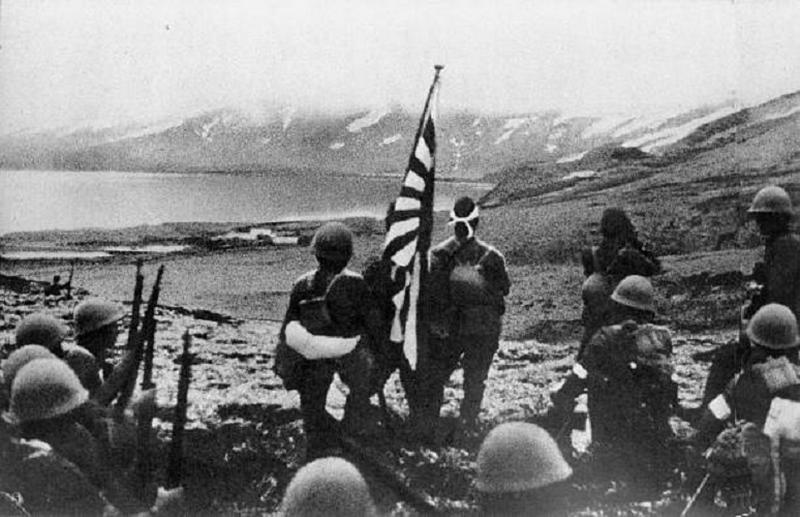When Japan Invaded Alaska
By Linda Speckhals | November 19, 2022

During World War II, in what has been called the “Forgotten Battle,” Japan invaded Alaska. Japan was already gathering information about the Aleutian Islands before they entered World War II. Japanese intelligence found that the nearest field for land-based American aircraft was at Fort Morrow on Kodiak. Because this was more than 600 miles from Dutch Harbor, it meant that Dutch Harbor in the Aleutian Islands was vulnerable. Additionally, the chain of 150 islands is only 750 miles away from the closest military base in Japan, making them closer to Japan than to Seattle, Washington. When the Japanese Northern Area Fleet, commanded by Vice-Admiral Boshiro Hosogaya was provided with a force that included aircraft carriers, submarines, and troop transports, Hosogaya first launched an air attack against Dutch Harbor; this was followed by an amphibious attack against the island of Adak, which was 480 miles west of Dutch Harbor. Because the information the Japanese had gathered was not up-to-date, the Japanese were not aware that Adak was undefended, and the forces returned to their ships. The ships then became a reserve for two other landings: on Kiska, and Attu.

The Attack On Dutch Harbor
Beginning on June 3, 1942, the Japanese engaged in a two-day aerial bombing of the city of Unalaska, Alaska in Dutch Harbor. They used Nakajima B5N2 torpedo bombers, but only about half of them reached their objective, with the remaining ones becoming lost in the fog. These either returned to their carriers or crashed into the sea. The 17 Japanese planes located the naval base faced anti-aircraft fire and were quickly confronted by Eleventh Air Force fighters. The Japanese did not expect this response, and they quickly released their bombs before returning to their carriers, doing little damage to the base.
The Occupation Of Attu
The Japanese returned to Dutch Harbor on June 4, striking the oil storage tanks, partially demolishing the hospital, and damaging a beached barracks ship. On June 6, the Japanese occupied Kiska, and on June 7, they occupied Attu. Prior to the invasion, in May 1942, the U.S. had offered to evacuate Attu, but the Unangax chief refused, and then, when the Japanese invaded, the local Unangax, also known as Aleuts, gave little resistance. While the Japanese occupied Attu, life for the Unangax did not change much until September when the Japanese took them to an internment camp in Hokkaido Japan.
Americans Were Terrified Of The Japanese
The Japanese action led the U.S. to forcibly evacuate the remaining Uganax in the Aleutian Islands and place them in internment camps in the Alaskan Panhandle. The occupation also led many Americans to fear that the Japanese would use the Aleutian Islands as bases to strike along the U.S. West Coast, and cities like Anchorage, Seattle, and San Francisco would be vulnerable to attacks. By this point, the Japanese had bombed China relentlessly and were practically invincible, heightening the fears. Around the same time, the Army Corps of Engineers was constructing the Alaska Highway, and fears of the Japanese and the need to get supplies to troops fueled the need to complete construction.

An Air Force Base On Adak
The Air Force established an airbase on Adak by August and started bombing Japanese positions on Kiska; submarines and surface ships began patrolling the waters and sank several Japanese ships in Kiska Harbor.
Operation Landcrab
The American forces began a campaign called “Operation Landcrab” to recapture Attu on May 11, 1943. However, they faced challenges from a combination of forces: a shortage of landing craft, unsuitable beaches, and weather that caused equipment to fail. American soldiers also suffered frostbite, and vehicles couldn’t operate on the tundra.
The Attack Near Massacre Bay
When the American forces attacked, the Japanese forced them far from shore, which also caused problems. After the fierce combat, there was a total of 3,829 U.S. casualties, some of which came from the cold weather. The remainder of the Japanese forces attacked near Massacre Bay in what was recorded as one of the largest banzai charges of the Pacific campaign. By the end, the Japanese force was practically exterminated, and only 28 Japanese soldiers were taken prisoner.
Retaking The Islands
The Americans then set out to retake Kiska; the force included both Americans and Canadian troops. When they landed on August 15, 1943, they found that the Japanese had deserted the island two weeks earlier. The Air Forces bombed the abandoned positions for three weeks, nevertheless. Despite the absence of Japanese forces, the Allied troops suffered 313 casualties which came from friendly fire, booby traps, disease, mines, timed bombs, vehicle accidents, and frostbite.